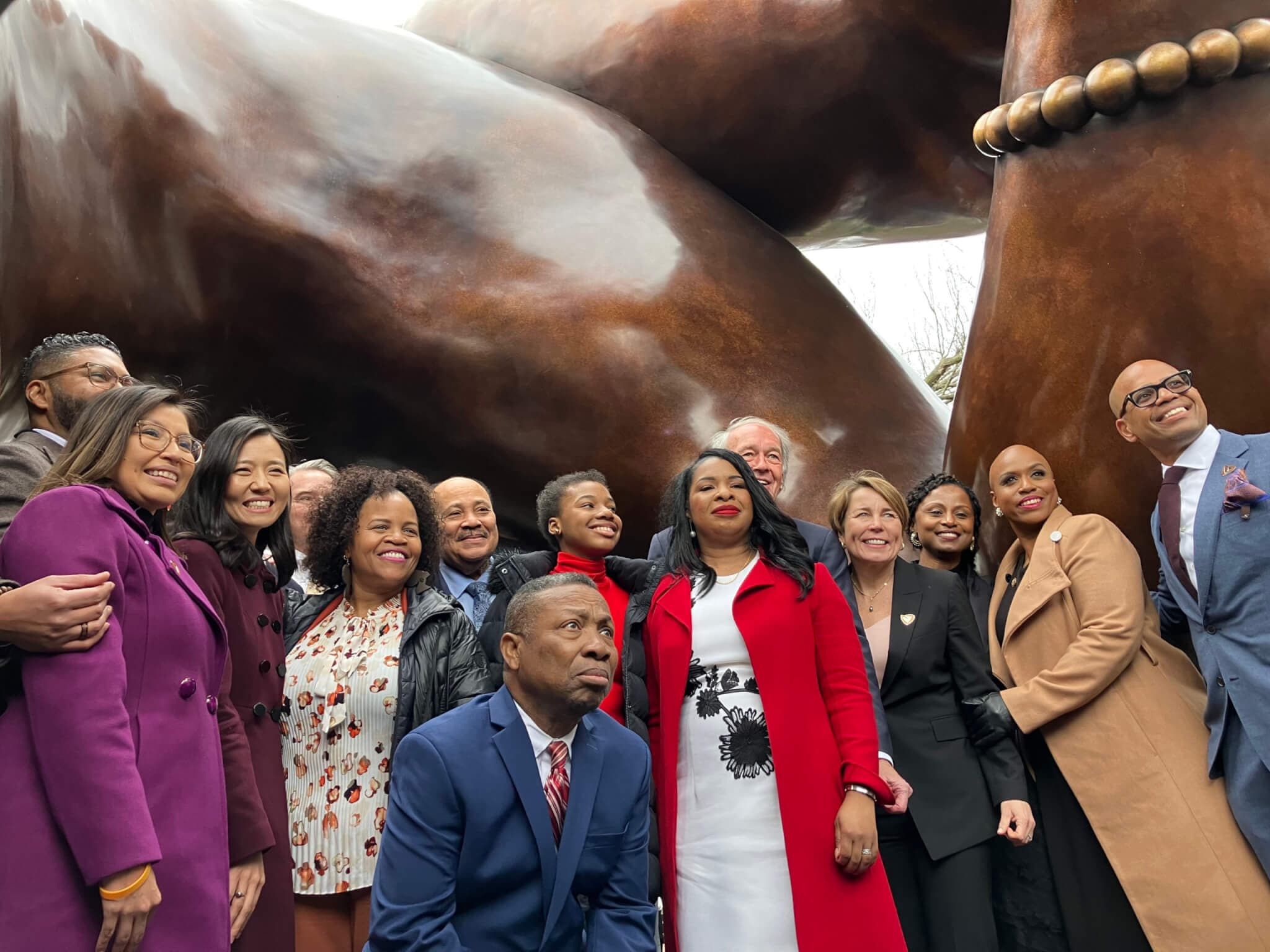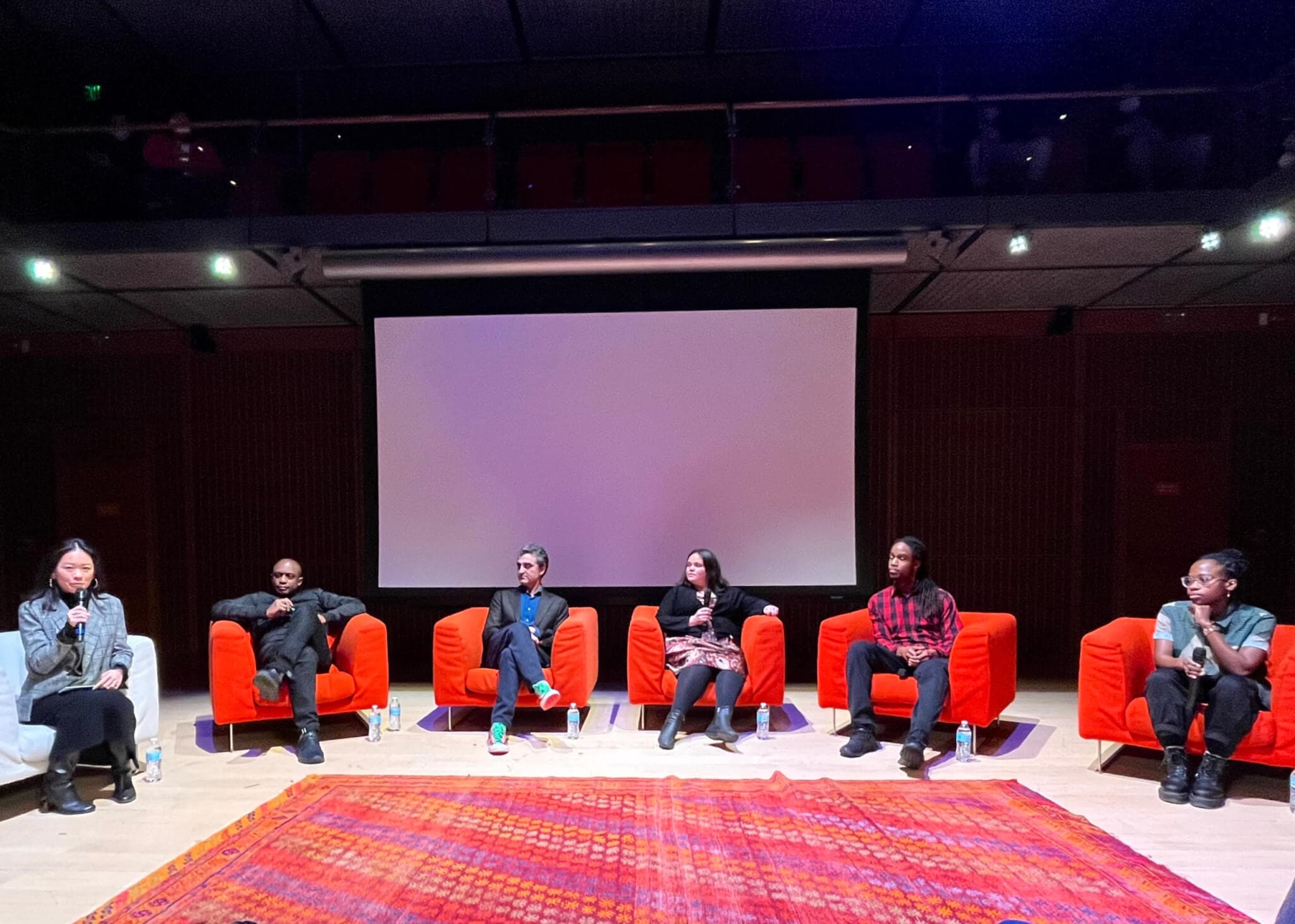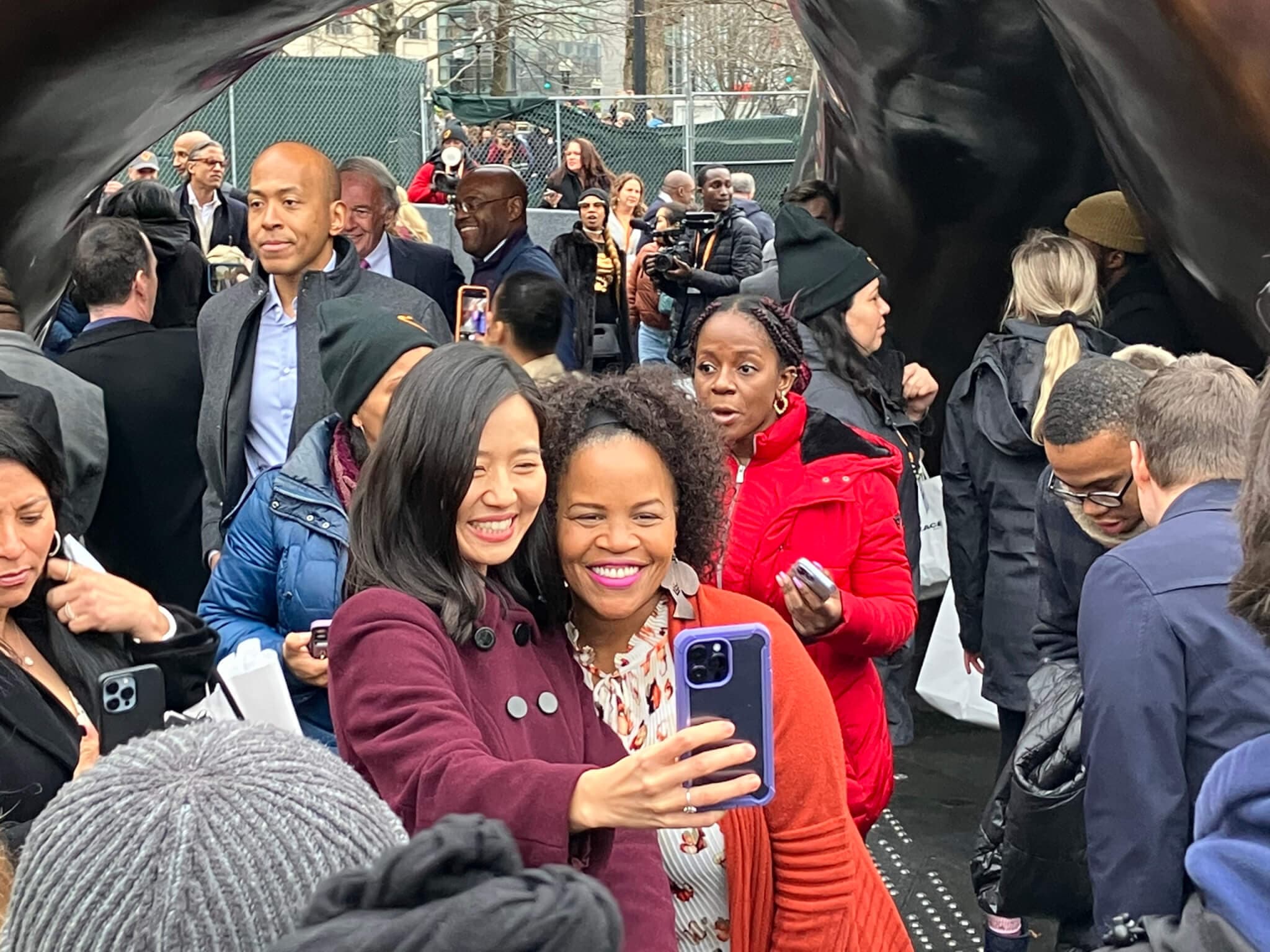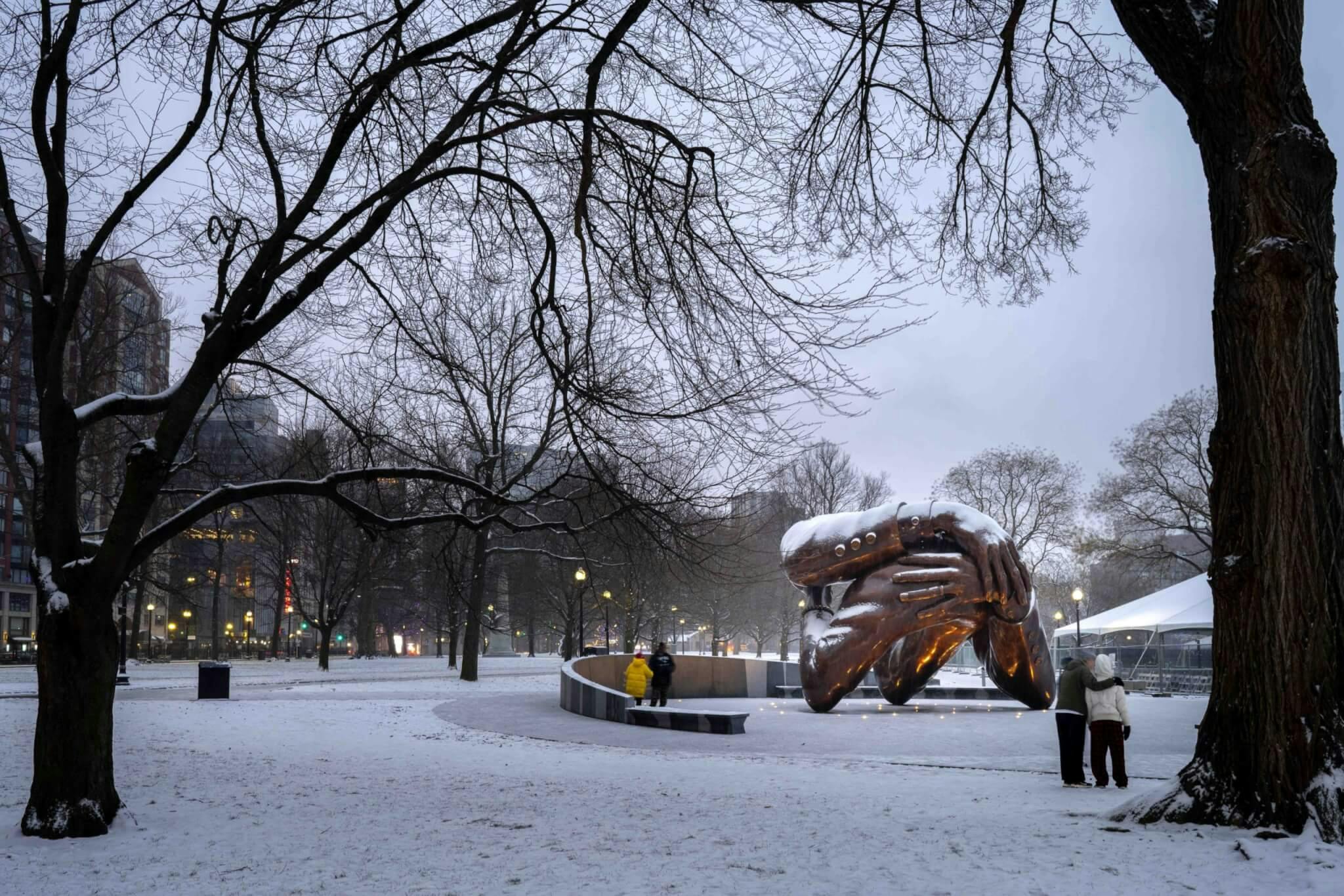On Friday, January 13, a memorial to Rev. Dr. Martin Luther King Jr. and Coretta Scott King was unveiled on Boston Common, our nation’s oldest public park. The two-story bronze sculpture depicts two sets of disembodied arms wrapped around one another in, well, an embrace. The 3D rendering created by artist Hank Willis Thomas and MASS Design Group was inspired by a photo of the Kings sharing a hug after learning Dr. King had won the Nobel Peace Prize in 1964. For Bostonians, the sculpture is a homecoming of sorts, one that calls attention to the love between Coretta and Dr. King that was sparked here in Boston and reverberated around the world.
Dr. King was born in Georgia but moved to Boston to pursue his doctorate degree at Boston University. From 1951 to 1954, King served as assistant minister at Twelfth Baptist Church, which was located in Boston’s South End before relocating to the area we now call Nubian Square. At the time, Coretta Scott was studying at the nearby New England Conservatory of Music. Their first introduction was by telephone, a moment depicted by artist Rob “ProBlak” Gibbs on the site of the former Twelfth Baptist Church in his mural Roxbury Love Story (2020). By 1953, the Kings were married and lived together just a mile from the church in the South End area. In 1954, they were on their way to Alabama, where, in the following ten years, his role as a minister would transform into that of an organizer.
In April of 1965, Dr. King returned to Boston to lead the first Freedom March in the Northeast, with a crowd of 22,000 people marching from Roxbury to Boston Common. While here, Dr. King spoke to a joint convention of the Massachusetts legislature, calling on them to address issues including de facto segregation and barriers to voting access. When speaking of this event, Dr. King shared with the Boston Globe: “Little did I imagine that such a day was possible when I walked through this same Boston Common as a student ten years ago,” nodding to his time as a student at Boston University. “This will go down as one of the greatest days that Boston has ever seen.” And later, he emphasized, “The vision of the New Boston must extend into the heart of Roxbury.” Is The Embrace a vision of King’s “New Boston”?
When Embrace Boston (formerly King Boston), the nonprofit behind the memorial founded by tech entrepreneur Paul English, sought to erect a new public monument, they convened civic and religious leaders, artists, and scholars to oversee an open call for proposals. In 2019, artist Hank Willis Thomas was selected alongside MASS Design Group from 126 submissions. Unlike the four other finalists, Thomas’s proposal was the only piece that boldly incorporated both Dr. King and Coretta’s legacies here in Boston. In Thomas’s design, the sculpture sits atop a circular plaza honoring sixty-nine local civil rights leaders who were active from the 1950s through the 1970s.

Elected officials and distinguished guests, including (from left to right): Miriam Ortiz, Imari Paris Jeffries, Mayor Michelle Wu, former mayor Kim Janey, Martin Luther King III, Yolanda Renee King, Arndrea Waters King, Sen. Ed Markey, Gov. Maura Healey, Sen. Ayanna Pressley, and Demond Martin, among others gathered under the sculpture.
This past Friday, Boston community members came out by the hundreds to celebrate these legacies. The rainy skies and muddy grass couldn’t stifle the energy that was present as the curtain was pulled from the massive sculpture. The event, which featured nearly two hours of speeches, musical performances, and dedications, was designed—like the sculpture—to inspire and spark dialogue.
And it did just that. Across the internet, the memorial is being met with mixed reviews, with most online commenters taking jabs at the shape of the sculpture, critiquing the $10 million budget, and oddly, questioning Boston as site for this memorial altogether. Locally, community members are probing at who this sculpture is meant to serve and what comes next for Boston’s Black communities. It’s important to remember that these conversations are a crucial—and frankly, expected—part of any effective public art unveiling.
Artist Steve Locke, whose proposal for a memorial dedicated to enslaved peoples at Faneuil Hall was halted amidst political and community debate in 2019, spoke plainly to this conundrum: “You can have an entire years-long public process… and people will still claim that the ‘community’ did not have sufficient input in public art,” he wrote in an Instagram post on January 16.
In any case, when we celebrate the significance of particular legacies, we also highlight the most pressing gaps toward progress. At a panel organized by For Freedoms (an artist collective cofounded by Thomas) and hosted at the Isabella Stewart Gardner Museum, artist Erin Genia, an enrolled member of the Sisseton-Wahpeton Oyate, spoke to the complicated nature of monuments writ-large, citing the histories of genocide and white supremacy that are embedded in public spaces. “What’s important to consider whenever we are thinking about public space is that it’s all Native land,” she said. “We have this idea of public space as utopia, but what is underneath it?”

On Monday, January 16, For Freedoms presented a Town Hall at the Isabella Stewart Gardner Museum in conjunction with their Dr. Martin Luther King Jr. Day of Service. Pictured left to right: Yng-Ru Chen, Hank Willis Thomas, Eric Gottesman, Erin Genia, Eric M. Anderson, and Sabrina Dorsainvil. Photo by Boston Art Review.
A similar sentiment was expressed during Friday’s unveiling event as speakers, including elected officials, civic leaders, and even Dr. King’s only granddaughter, spoke to the work that needs to be done going forward.
Yolanda Renee King, 14, moved the crowd to tears when she came to the mic. “There are days when I just never want to do this work again, and days when it’s tough and days when I feel sad,” she shared. “But then I see the love and then I see so many people who also feel the same way as me…. This is almost like love 360.”
During the unveiling, the panel, and in conversations throughout the weekend, artists and community members discussed the magnitude of a work like The Embrace—not simply in size or scope—but in longevity. During Monday’s panel, director of Praise Shadows Art Gallery Yng-Ru Chen asked Thomas directly about how he navigated this pressure, particularly given that he was creating a memorial for a city that was not his own. He referenced James Baldwin in response, noting, “When you come from a place that you don’t know, you’re able to do things that other people can’t do.” Thomas cited relying on collaborators and advisors to create a piece that would translate both locally and broadly. “I wanted to look back and get into the complexities of this place… but I’m also thinking about my great grandchildren and hope they can feel the love of the Kings.”

Hundreds gathered on Friday, January 13, to celebrate the official unveiling of The Embrace and the 1965 Freedom Rally Memorial Plaza.

Mayor Michelle Wu and her predecessor Kim Janey grab a selfie shortly after the unveiling of The Embrace. Photo by Boston Art Review.
One of those collaborators, Jha D Amazi, a principal architect at MASS Design Group, shared what participating in the making of the monument meant to her in this moment. “If you add the layers and the intersectionality of my Blackness, my womanhood, of being a native of Boston, and then to be offered the opportunity as a young Black architect educated in this city to participate in a moment like this, where we honor the Black experience, Black joy, Black love, in the oldest park in the country…” she said while holding back tears.
To begin Monday’s panel session, local artist Sabrina Dorsainvil asked members of the audience to close their eyes, bring their left hand to their right shoulder, their right hand to their left shoulder, and give themselves a hug. In unison, those in attendance embraced themselves, a reenactment of the statue on the Common, of the care and compassion that the Kings shared with each other and for their community.
Among the many quotes from Coretta Scott King shared by speakers throughout Friday’s ceremony, artist Hank Willis Thomas chose this one: “The beloved community is a realistic vision of an achievable society, one in which problems and conflicts exist, but are resolved peacefully and without bitterness.” The Embrace Boston organization indeed has bold plans for the community, not the least of which includes developing the P3 parcel in Nubian Square into the Embrace Center. According to the Boston Foundation, the center will be a “hub and anchor for the Black community” and will include exhibition, workshop, and performance spaces.
Gina Lindner, communications manager at Boston Art Review, and Jessica Shearer, editor at Boston Art Review, also contributed to this article.
This is a developing story.





